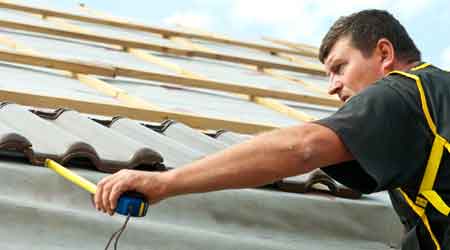Protecting Your Roof against Damaging Winter Weather
First of a 2-part article on 10 steps you can take to prevent roof
failure during the cold winter months
The National Roofing Contractors Association (NRCA) and the Roof Consultants Institute (RCI) have long recommended having roofs inspected twice each year, once after the hottest weather, and once after the coldest weather, as well as after any major weather event. Winter weather can be very damaging to roofs when proper precautions are not taken; its high winds and ice can be especially damaging. Performing regular inspections and scheduling repairs during fair weather — fall, for instance, is a good time for a pre-winter check-up — are the best strategies for avoiding emergency and unplanned roof repair.
While most contemporary roofs qualify for a least a 20-year warranty, a roof is not necessarily expected to perform for 20 years with no maintenance. According to NRCA, the average life of a low-slope roof in the United States is 13 to 14 years. Low-slope roofs are defined as those having a slope of less than 3 inches in 12 (3:12), which includes most commercial, industrial, and institutional buildings.
Low-slope roofs are generally modified bitumen systems, single-ply systems, gravel-surface built-up systems, or in some cases, structural standing seam metal roofs. The difference between actual average roof lives and rated roof lives is related to design, materials, workmanship, and owner maintenance. After a building is completed, the first three of those factors may be outside the owner’s control, but maintenance is not.
Many of the problems created by cold winter weather can be prevented by taking advance precautions, which vary with the type of roof:
1. The first step is always to inspect the roof for obvious points of concern. In general, owners should not attempt to inspect steep roofs themselves. For safety reasons, a steep roof should always be inspected by an experienced professional who is trained in proper methods of fall protection and has the safety equipment, harnesses, and life lines to tie off properly. The inspection should cover items such as loose chimney caps, vent covers, and loose tiles, shingles, or flashings.
2. On low-slope roofs, a simple walk over the entire roof can reveal many maintenance items, which can be easily corrected. Loose flashings and metal trim should be secured to avoid moisture and ice entry points. Screws and fasteners should be tightened and other minor maintenance elements fixed. Appurtenances such as lightning protection, antennas, and security cameras should be secured.
3. Cleaning the roof is a very important element of winter preparation. Leaves and other accumulated trash and debris should be removed. Loose objects such as bottles or beverage containers should also be removed. Tennis and soccer balls commonly accumulate on single-story building roofs, particularly schools. Loose wiring and conduit should be collected, properly secured, supported, and moved out of the way. All items that are not part of the roof assembly and its functioning elements should be removed.
4. Ensuring that roof drainage is unimpeded is one of the most important elements in winter preparation. Water weighs 5 pounds per square foot per inch deep and can cause roof collapse when excessive. When water is allowed to freeze on the roof, the ice can clog drains, scuppers, gutters, conductor heads, and downspouts. The best way to prevent ice on a low-slope roof is to avoid obstructions to the drainage system. Check the roof drains for buildup of vegetation, and be sure the drains are not clogged further down the piping. Water-test the roof drains by running water down each drain from a garden hose. The same applies to through-wall scuppers and downspouts. Check for bird nests and plastic bottles in conductor heads. Overall, the goal is to ensure that water drains from the roof efficiently and quickly. Not only can ice damage roofs by the expansion of water caused by freezing, it also increases the likelihood of slips and falls by maintenance personnel while they on the roof.
Related Topics:













